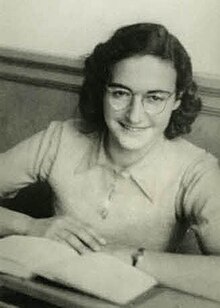Margot Frank

Margot Betti Frank (* 16 February 1926 in Frankfurt am Main , † the beginning of March 1945 in Bergen-Belsen ) was a originally from Germany originating Jewish - Dutch victims of the Holocaust . She became known as the three years older sister of Anne Frank through her famous diary .
Life
Margot Frank was born as the first child of her parents Otto Frank and Edith Frank-Holländer . She was given the name Betti in memory of her mother's sister, who died early.
In Frankfurt Margot first attended the Ludwig Richter School, later the Varrentrapp School, and also received Jewish religious instruction.
The Frank family moved to the seizure of power of the Nazis in 1933 in 1934 from Frankfurt in Germany to Amsterdam in the Netherlands in an apartment on the Merwedeplein 37 in the quarter Rivierenbuurt (German: River District ) over. Margot attended the nearby public school on Jekerstraat. After the Germans occupied the Netherlands during World War II in 1940, Margot and Anne went to school at the Jewish Lyceum after Jews were banned from attending non-Jewish schools.
Margot Frank has been described by many survivors as the perfect daughter. She was good, calm and got good grades in school. She had the plan to emigrate to the then Mandate Palestine after the war to become a midwife there.
Soon after the occupation of the Netherlands, Otto Frank began to prepare a hiding place for his family and the befriended van Pels family in the rear building of the Dutch branch of the Opekta -Werke, which he had previously managed .
On July 5, 1942, Margot received an appeal to report to be transported to a labor camp in Germany. The family then went into hiding the following day, the van Pels family followed later, a few months later Fritz Pfeffer , an acquaintance, followed. In the hiding place, the people in hiding were looked after by friendly employees from the company. Margot was always very calm and reserved in hiding, so that the helper Miep Gies could later only say about her: "She was there and that was all".
On August 4, 1944, the hiding place was discovered, either through treason or in the course of some other investigation into the black market, and the people in hiding were arrested. They were first taken to the Westerbork transit camp and then deported with the last transport to the Auschwitz-Birkenau concentration camp . There they were separated from each other.
Margot and Anne were taken to the Bergen-Belsen concentration camp on another transport in October 1944. Margot died there in March 1945 a few days before her sister and a few weeks before the concentration camp was liberated.
Like Anne, Margot kept a diary during the war, but this was not found.
Appreciation
In front of the Frank family's apartment at Pastorplatz 1 in Aachen, stumbling blocks embedded in the sidewalk remind of the fate of the family. Since February 2015, Stolpersteine have also been a reminder of the family at her last official place of residence at Merwedeplein 37 in Amsterdam.
Margot Frank was portrayed in the feature film The Diary of Anne Frank (1959) by Diane Baker and in Anne Frank (2001) by Jessica Manley . She was portrayed by Emma Harbor (1987) and Felicity Jones (2001) in the two BBC productions The Diary of Anne Frank . In the 2016 film The Diary of Anne Frank , directed by Hans Steinbichler , Stella Kunkat plays Margot.
Web links
Individual evidence
- ^ Anne Frank Stichting - Anne Frank's family
- ↑ a b Carol Ann Lee : Otto Frank's secret. Munich 2005, ISBN 3-492-04477-8 .
- ^ Anne Frank Stichting - The eight people in hiding
- ↑ Dr. Gertjan Broek: anne frank stichting - August 4, 1944. (PDF; 5 p., 158 KB) Anne Frank Foundation, December 2016, accessed on April 11, 2017 (English).
- ↑ Anne Frank: Merwedeplein 37, Amsterdam
| personal data | |
|---|---|
| SURNAME | Frank, Margot |
| ALTERNATIVE NAMES | Frank, Margot Betti (full name) |
| BRIEF DESCRIPTION | German-Dutch victim of the Holocaust, sister of Anne Frank |
| DATE OF BIRTH | February 16, 1926 |
| PLACE OF BIRTH | Frankfurt am Main |
| DATE OF DEATH | March 1945 |
| Place of death | Bergen-Belsen concentration camp |

